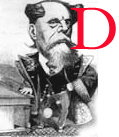 ickens said so little about his own practices as a humorist, and that little is so contradictory, that it is almost without value for criticism. He spoke at one time about being required "to restrain myself from launching into extravagances" in the enjoyment of his "preposterous sense of the ridiculous"; on the other hand, he said later that he had "such an inexpressible enjoyment of what I see in a droll light, that I dare say I pet it as if it were a spoilt child"; and he sometimes implied in letters to potential contributors to his journals that they should "administer" humour as a relief. Dickens's direct comments mix the obscure and the superficial and tell us little or [17/18] nothing about his practice. Perhaps one of his more indirect statements is more revealing: "You write to be read, of course" (to John Forster, Life, i. 419; to Edward Bulwer-Lytton, Life, ii. 273; to Percy Fitzgerald, Letters, iii, 393, 27 July 1864; to Miss Emily Jolly, Letters, ii. 679, 17 July 1855).
ickens said so little about his own practices as a humorist, and that little is so contradictory, that it is almost without value for criticism. He spoke at one time about being required "to restrain myself from launching into extravagances" in the enjoyment of his "preposterous sense of the ridiculous"; on the other hand, he said later that he had "such an inexpressible enjoyment of what I see in a droll light, that I dare say I pet it as if it were a spoilt child"; and he sometimes implied in letters to potential contributors to his journals that they should "administer" humour as a relief. Dickens's direct comments mix the obscure and the superficial and tell us little or [17/18] nothing about his practice. Perhaps one of his more indirect statements is more revealing: "You write to be read, of course" (to John Forster, Life, i. 419; to Edward Bulwer-Lytton, Life, ii. 273; to Percy Fitzgerald, Letters, iii, 393, 27 July 1864; to Miss Emily Jolly, Letters, ii. 679, 17 July 1855).
Naturally, a good many writers do write to be read, but the rhetorical emphasis is important. Dickens held as an unquestionable assumption the notion that one wrote to someone. And though I do not want to present him as a calculating journalist, easily and cheaply manipulating the feelings of his readers, the evidence for Dickens as a rhetorician, a man constantly aware of and in touch with his audience, is, as has often been recognized, very strong. He spoke of his relationship to his public as "personally affectionate and like no other man's", and he loved to tell the story of the lady who stopped him to ask if he would let her "touch the hand that has filled my house with many friends" (Forster, Life, ii. 205 and ii. 221) Certainly Dickens did think of his novels, at least partially, as periodic communications with his affectionate readers; he wrote with the reader very much in mind; and he was very much concerned with that reader's feelings: "You cannot interest your readers in any character unless you have first made them hate, or like him" (to John Overs, Letters, i. 255, 12 Apr. 1840). The emphasis on emotional response is significant. Further, as John Butt and Kathleen Tillotson suggest, he used John Forster "as a judge of what the average reader would stand" (Butt / Tillotson, p. 23), as a rhetorical sounding-board, in other words. Such famous queries to Forster, then, as the one concerning the projected evil course of Walter Gay — "Do you think it may be done, without making people angry?" (Forster, Life, ii. 21) can be seen not so much as a request for a critical opinion as an idea thrown out against a representative audience for testing. "Does it make you angry?" is the real question. Forster was, among other things, insurance against a disruption of the affectionate communication.
Dickens's extreme sense of intimacy with his audience was partly responsible for his decision to publish his explanation of the separation from his wife and to embark on his series of [18/19] readings. If one can judge from his letters, what excited him most about these readings was the particularly warm and personal response of his audience: "The affectionate regard of the people exceeds all bounds and is shown in every way. The audiences do everything but embrace me, and take as much pains with the readings as I do" (to John Forster, Life, ii. 359). The last phrase strikes exactly the right note in regard to Dickens's rhetoric: the reader must participate equally with the writer in the experience and in the theme. Dickens's use of laughter is a major element in allowing — indeed forcing — us to do so.
Again, this is not to say that Dickens planned his novels simply in terms of controlling our responses. Nor does this approach necessarily rule out the time-honoured view of Dickens as a deeply unconscious or hallucinatory writer. Both aspects are undoubtedly part of his art. Whether we see Dickens as consciously manipulating his work or unconsciously projecting his view of society does not really matter. It remains true in either case that the use of our laughter is an extremely powerful instrument of rhetoric, persuasive and incisive in its accuracy, and applicable to us in its contribution to the total vision contained in Dickens's novels.
References
Butt, John, and Tillotson, Kathleen. Dickens at Work. London, 1957.
Forster, John. The Life of Charles Dickens. Notes by A. J. Hoppé. London, 1966.
The Letters of Charles Dickens, ed. Walter Dexter, 3 vols. London, 1938.
Last Modified 10 March 2010
